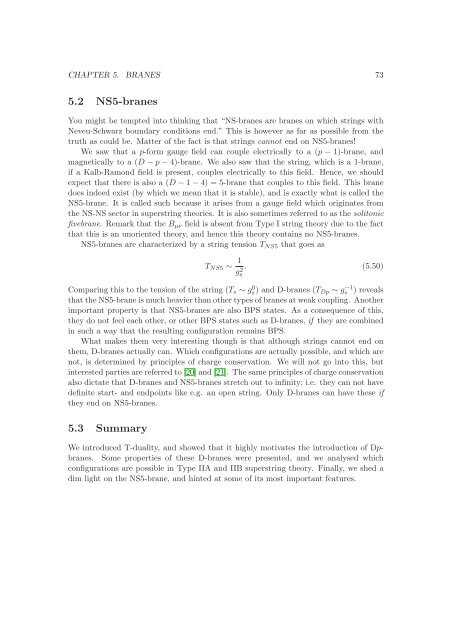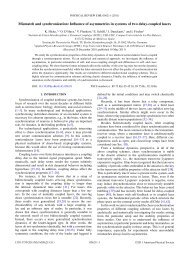DBI Analysis of Open String Bound States on Non-compact D-branes
DBI Analysis of Open String Bound States on Non-compact D-branes
DBI Analysis of Open String Bound States on Non-compact D-branes
You also want an ePaper? Increase the reach of your titles
YUMPU automatically turns print PDFs into web optimized ePapers that Google loves.
CHAPTER 5. BRANES 735.2 NS5-<strong>branes</strong>You might be tempted into thinking that “NS-<strong>branes</strong> are <strong>branes</strong> <strong>on</strong> which strings withNeveu-Schwarz boundary c<strong>on</strong>diti<strong>on</strong>s end.” This is however as far as possible from thetruth as could be. Matter <str<strong>on</strong>g>of</str<strong>on</strong>g> the fact is that strings cannot end <strong>on</strong> NS5-<strong>branes</strong>!We saw that a p-form gauge field can couple electrically to a (p − 1)-brane, andmagnetically to a (D − p − 4)-brane. We also saw that the string, which is a 1-brane,if a Kalb-Ram<strong>on</strong>d field is present, couples electrically to this field. Hence, we shouldexpect that there is also a (D − 1 − 4) = 5-brane that couples to this field. This branedoes indeed exist (by which we mean that it is stable), and is exactly what is called theNS5-brane. It is called such because it arises from a gauge field which originates fromthe NS-NS sector in superstring theories. It is also sometimes referred to as the solit<strong>on</strong>icfivebrane. Remark that the B µν field is absent from Type I string theory due to the factthat this is an unoriented theory, and hence this theory c<strong>on</strong>tains no NS5-<strong>branes</strong>.NS5-<strong>branes</strong> are characterized by a string tensi<strong>on</strong> T NS5 that goes asT NS5 ∼ 1 gs2 . (5.50)Comparing this to the tensi<strong>on</strong> <str<strong>on</strong>g>of</str<strong>on</strong>g> the string (T s ∼ g 0 s) and D-<strong>branes</strong> (T Dp ∼ g −1s ) revealsthat the NS5-brane is much heavier than other types <str<strong>on</strong>g>of</str<strong>on</strong>g> <strong>branes</strong> at weak coupling. Anotherimportant property is that NS5-<strong>branes</strong> are also BPS states. As a c<strong>on</strong>sequence <str<strong>on</strong>g>of</str<strong>on</strong>g> this,they do not feel each other, or other BPS states such as D-<strong>branes</strong>, if they are combinedin such a way that the resulting c<strong>on</strong>figurati<strong>on</strong> remains BPS.What makes them very interesting though is that although strings cannot end <strong>on</strong>them, D-<strong>branes</strong> actually can. Which c<strong>on</strong>figurati<strong>on</strong>s are actually possible, and which arenot, is determined by principles <str<strong>on</strong>g>of</str<strong>on</strong>g> charge c<strong>on</strong>servati<strong>on</strong>. We will not go into this, butinterested parties are referred to [20] and [21]. The same principles <str<strong>on</strong>g>of</str<strong>on</strong>g> charge c<strong>on</strong>servati<strong>on</strong>also dictate that D-<strong>branes</strong> and NS5-<strong>branes</strong> stretch out to infinity; i.e. they can not havedefinite start- and endpoints like e.g. an open string. Only D-<strong>branes</strong> can have these ifthey end <strong>on</strong> NS5-<strong>branes</strong>.5.3 SummaryWe introduced T-duality, and showed that it highly motivates the introducti<strong>on</strong> <str<strong>on</strong>g>of</str<strong>on</strong>g> Dp<strong>branes</strong>.Some properties <str<strong>on</strong>g>of</str<strong>on</strong>g> these D-<strong>branes</strong> were presented, and we analysed whichc<strong>on</strong>figurati<strong>on</strong>s are possible in Type IIA and IIB superstring theory. Finally, we shed adim light <strong>on</strong> the NS5-brane, and hinted at some <str<strong>on</strong>g>of</str<strong>on</strong>g> its most important features.
















